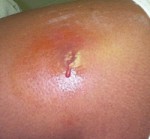The majority of Staph and MRSA infections are on the skin. Unfortunately, a MRSA skin infection can cause unsightly and embarrassing sores, sometimes leaving permanent scars on the skin. Open wounds and lesions can be quite contagious and help the infection to spread to others. Fortunately, infections of the skin are often less severe than an internal Staph or MRSA infection and treatment can be easier.
MRSA and Staph Symptoms
Skin MRSA and Staph infections often form pimples or bumps, sometimes with pus filled heads. The surrounding skin is usually swollen, red and tender. The infected area may also be itchy, painful and warm to the touch.

Red, swollen, and draining Staph infection
MRSA on the skin often looks like a spider bite. In fact, MRSA is often misdiagnosed by doctors as a spider or insect bite. Misdiagnosis will delay getting the right treatments and can make the infection grow worse. The best way to tell if you have MRSA or not is to get a simple MRSA test from your doctor.
MRSA and Staph skin infections prefer moist, sweaty areas of the skin, especially places that are irritated or get friction from clothing. The nose, neck, arm pits, groin and “rear end” are commonly infected areas. These infections can become deeper in the skin, forming pus filled abscesses. More serious deep skin infections called cellulitis can form larger swelling and reddening of the infected area, and may have red radial streaks on the skin.
MRSA Skin Infection Treatments
Most doctors prescribe antibiotic drugs for MRSA and Staph skin infections. Most antibiotic courses are taken internally for a week or two. Antibiotics can also be applied to the skin infection itself in a gel or ointment. But while these drugs may stop an infection, they can also weaken the immune system, cause serious side effects and can increase the risk of recurring infections.
Many natural treatments and remedies are helpful for skin MRSA and Staph, including therapeutic essential oils, Manuka honey, certain garlic products and herbal remedies. These natural methods have the benefit of supporting the immune system as well as fighting the infection. Side effects are usually minimal and most methods are affordable and easy to use. The trouble is, you probably won’t hear anything about natural methods from your doctor.
As with any natural remedy, best results will come from products with the proper potency, quality and formulation. Most natural remedies lack the strength needed for support with stubborn Staph and MRSA infections. Some people find consulting with a natural doctor helpful in finding and using natural methods that work.
More than Skin Deep
If you have a skin Staph or MRSA infection, then the bacteria are likely inside your body too. These bacteria like to hide inside the body in biofilms and cause future infections. That’s why supporting your body internally is just as important as treating the infected area directly.
Several natural remedies can be used internally to support the body with Staph and MRSA, including special herbal formulations, therapeutic grade essential oils and even Manuka honey. These natural remedies can be very effective and are generally safe and easy to use.
An important part of internal support is to change the “terrain” inside your body. This is especially important if you’ve taken antibiotics. Unless conditions inside the body change, the same conditions that caused the first infection can easily cause recurring infections later.
To your best health,
Michelle
Microbiologist and Natural Health Expert
Photo Credit: CDC/Coignar





